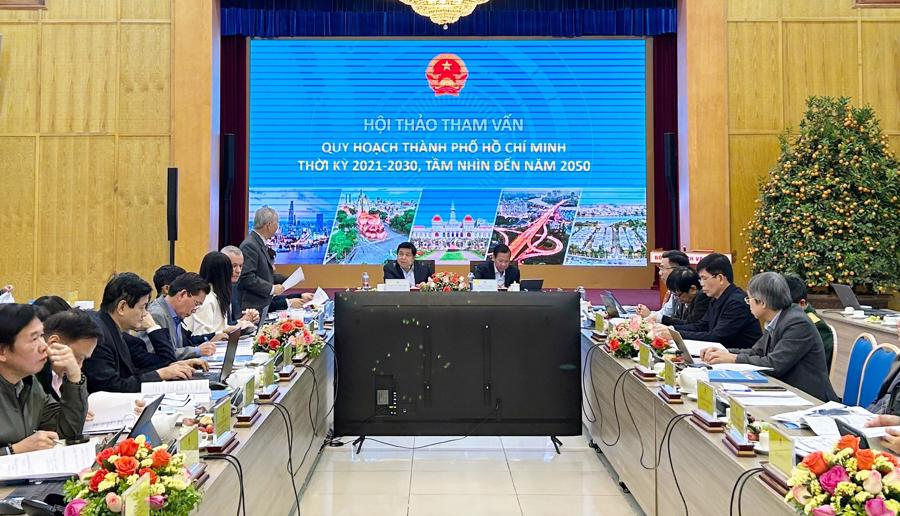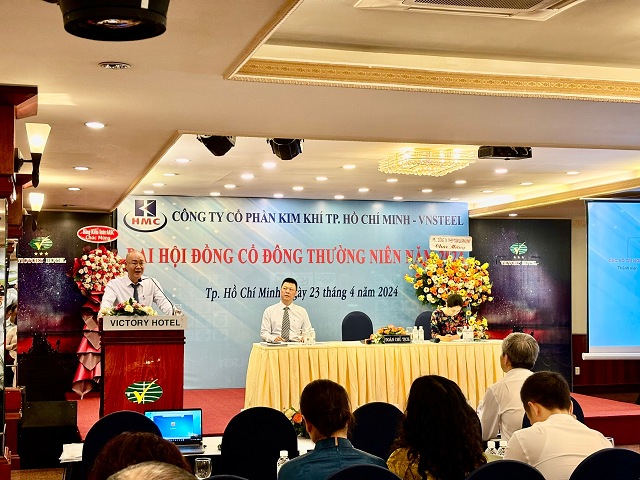That is the statement of Professor, Doctor, and Architect Tran Trong Hanh at the consultation conference on the planning of Ho Chi Minh City for the period 2021-2030 and the vision until 2050 on February 28.
The Minister of Planning and Investment Nguyen Chi Dung and the Chairman of the Ho Chi Minh City People’s Committee Phan Van Mai co-chaired the conference. The conference was connected online with the city’s leadership, leaders of departments and sectors of the City.
UNTAPPED POTENTIAL, BREAKTHROUGHS, AND UNEXPLORED CREATIVITY
In his opening remarks, Minister Nguyen Chi Dung emphasized the potentials, advantages, development bottlenecks, and open discussions on topics to help the city build the highest-quality plan, creating opportunities for development in the upcoming period.
Minister Nguyen Chi Dung highly appreciated the city’s leadership in planning work, which is an opportunity for the City’s development in the future. Currently, the legal framework, political system, and basic planning have been completed; the resolutions on the development of the Southeast region, the resolution on Ho Chi Minh City’s development, the national overall planning, regional planning, sectoral planning… are the basis for the city when building integrated and embedded planning to create new spaces, dynamics, and values.
Ho Chi Minh City is a special city, an important gateway connecting the Southeast region as well as the Mekong Delta region and with the area, the world. It is the leading economic center of the country in terms of economics, culture, education, training, science, and technology. It is the leading driving force with a large influence on the whole country.
However, in recent years, the city’s development has faced many difficulties and challenges, specifically untapped potentials, strengths, breakthroughs, and unexplored creativity that have not been efficiently utilized, not commensurate with extraordinary potentials, advantages, expectations, leading roles, and driving forces in both the region and the whole country, which are showing a declining trend.
In addition, the growth model and economic structure change slowly, the growth quality and labor productivity contribute less to the city’s growth compared to the average nationwide; the industrial proportion in the economic structure gradually decreases; the internal structure of the industry is outdated, relying mainly on labor-intensive industries, the service sector mainly relies on commerce, transportation, and high value-added industries such as finance, health care, education, and tourism have not yet played a leading role.
In addition, the organization of development space still has many shortcomings, not creating advantages for fast and sustainable development; many infrastructure and development spaces for industrial zones are limited; attracting investment and interconnecting within the city, inter-regional connectivity between the city and localities in the Southeast region, Mekong Delta region, and other economic regions in the country still have many limitations; not fully exploiting the potentials, strengths, and internal capacities of localities. As a result, the leading and spreading effects of the major economic center of the country for localities and surrounding areas have not been commensurate with potentials, advantages, and expectations. The advantage of the city’s international gateway will gradually decrease.
The urban infrastructure structure is overloaded compared to the rapid development of the population, slow development of the urban area’s infrastructure, especially the underground infrastructure leading to a low standard of living for urban residents. Traffic congestion, environmental pollution, flooding have been increasing in the context of the negative impact of climate change. Planning work and the implementation of urban planning still have many limitations, and the urban space structure is not suitable for a large city and a super city in the future, not fully exploiting the potentials, advantages of the riverside urban area, and coastal direction.
Clarifying the characteristics of Ho Chi Minh City, an extremely special city, accounting for only 0.6% of the country’s area but contributing nearly 20% of the GDP, 25% of the budget revenue… Minister Nguyen Chi Dung emphasized that Ho Chi Minh City is facing many difficulties: untapped potential, strengths, not effectively; the superiority, leadership is tending to decline; the GDP contribution rate in 2023 is only 16.5%.
“Other provinces and cities are surpassing, while Ho Chi Minh City is slowing down. In the coming time, the advantage of an international gateway will surely decrease,” Minister Nguyen Chi Dung suggested that participants in the conference contribute their opinions to choose the appropriate direction for Ho Chi Minh City.
Agreeing with the opinion of Minister Nguyen Chi Dung, Chairman of the Ho Chi Minh City People’s Committee Phan Van Mai added: “Planning for Ho Chi Minh City is not only for the city’s development and it cannot be done alone.”
Chairman Phan Van Mai expressed the desire that the conference will help identify more clearly the constraints, unleash the potential to help Ho Chi Minh City fulfill its role as a development center, not only in the Southeast region but also for the whole country and further, it is for the region.
HIGH GROWTH TARGETS, LACK OF INSTITUTIONAL BREAKTHROUGHS
Mr. Nguyen Dinh Cung, former Director of the Central Institute for Economic Management (CIEM), said that Ho Chi Minh City can aim for much higher growth. However, the bottleneck is the lack of institutional breakthroughs.

According to Mr. Cung, Ho Chi Minh City can choose the third option that the Draft proposes, which is a growth rate of over 10% and even higher, which is still feasible. The issue is whether we dare to choose, dare to have breakthrough thinking, different, having “non-traditional” decision-making mechanisms and solutions, different and decisive ways of doing things. South Korea, Japan… have had 10-15% annual growth for 20-30 years.
However, with the current reality, even with the second option that the Draft of the Ho Chi Minh City Planning has chosen, it is also challenging. Mr. Nguyen Dinh Cung analyzed that the average growth rate in the period 2021-2025 is 6.6%, in 2021 is 5.36%; 2022 is 9%; 2023 is 5.81%, so the average for the two years 2024-2025 must be 11.8%, twice as high as in 2023. This goal cannot be achieved in the current situation.
If the average growth rate for the two years 2024-2025 is only around 8-9%, then the period of 2026-2030 must have a higher growth rate, on average, around 12% to achieve an average growth rate of 8.3% for the period 2021-2030.
The former CIEM leader affirmed that this is an unattainable plan if the city continues to rely on existing business advantages and opportunities, lacking efforts to build new growth capacities. Therefore, there must be real breakthroughs to transform the growth model and implement the selected development plan.
Giving feedback on the City’s planning project, Professor, Doctor, and Architect Tran Trong Hanh, Head of the City Planning Project, confirmed: “The development model of “oil spills” (single-polar urbanization) is no longer suitable. Instead, the city must develop multiple poles, green, smart, ensuring sustainable environment. The new development model will also prevent mass migration and improve the quality of life for residents.”
Associate Professor Cao Viet Sinh, former Deputy Minister of Planning and Investment, suggested clarifying the role of Ho Chi Minh City in the region. Regarding the growth scenario, the scenarios mentioned in the plan are somewhat unreasonable. If the city only chooses an 8.3% growth (average scenario), the region cannot achieve 9% as determined in the regional plan, and the reasonable level must be 9%.
Also concerned about the economic and social growth, Mr. Chris Malone, CEO of Boston Consulting Group (BCG), said that the planning project focuses on spatial development, but it needs to pay more attention to economic and social development. He believes that greater focus should be placed on the economic development momentum of Ho Chi Minh City and assessing the impact of that development on GDP.
The Ministry of Planning and Investment raised five key issues that need to be clarified:
First, determining the current key issues that need to be resolved; breakthrough development stages during the planning period; whether the identified key issues that need to be resolved are reasonable or not; whether the content and the essence of the proposed breakthroughs are strong enough, breakthrough-oriented, commensurate with the development goals and the current challenges of the City.
Second, determining the City’s viewpoints, objectives, scenarios, vision, and mission in the planning period; whether the objectives are sufficient for Ho Chi Minh City to continue being the leading growth pole of the country as determined in Resolution No. 81/2023/QH15 dated January 9, 2023, of the National Assembly on the national overall planning for the period of 2021-2030 and the vision towards 2050.
Third, determining the priority economic sectors and developing solutions for those sectors; determining the orientation for the development of marine economy, high-tech economy, green economy, semiconductor industry, cultural industry, knowledge-based economy, circular economy, urban economy, etc.
Fourth, orienting the organization of development space; the industrial corridor, urban area, service area; the encouraged and restricted areas for development; ensuring the leading roles of growth poles in the City; building an international financial center associated with the City’s development space organization; the ability to create an attractive living and working space to attract resources, talents, and intellectuals from both inside and outside the country to work, live in Ho Chi Minh City; orienting, resolving issues regarding human resource quality, social security, ensuring political security within the City.
Fifth, giving opinions on the orientation of the City’s technical infrastructure development, including issues related to the development and efficient use of underground space, transport infrastructure, the development of digital infrastructure, the planning, and development of Cần Giờ International Transshipment Port; breakthrough solutions to address current challenges such as traffic congestion, environmental pollution, flooding; ensuring water security; Orienting solutions for cultural, social development, ensuring national defense-security, human resource development; the resources for implementation.





































